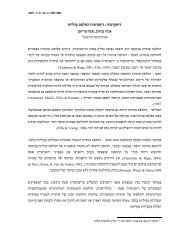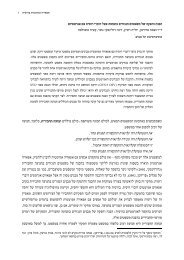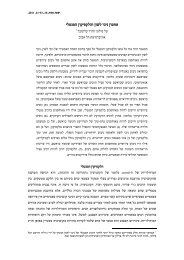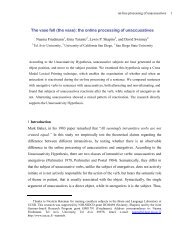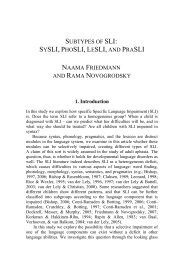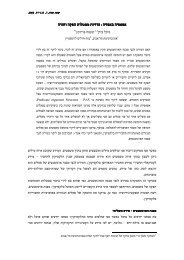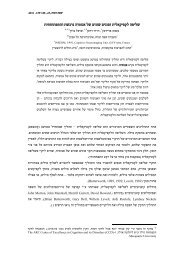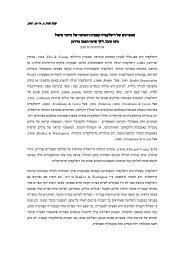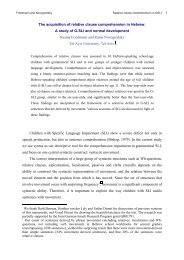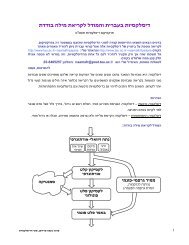Developmental surface dyslexias - Naama Friedmann
Developmental surface dyslexias - Naama Friedmann
Developmental surface dyslexias - Naama Friedmann
Create successful ePaper yourself
Turn your PDF publications into a flip-book with our unique Google optimized e-Paper software.
cortex 44 (2008) 1146–1160 1155<br />
The first subtype of developmental <strong>surface</strong> dyslexia, input<br />
<strong>surface</strong> dyslexia, was a deficit that related to the orthographic<br />
input lexicon. As a result, the eight individuals who had this<br />
type of developmental <strong>surface</strong> dyslexia were forced to read<br />
via the grapheme-to-phoneme conversion route, and therefore<br />
made regularization and potentiophone errors in reading.<br />
Because the orthographic input lexicon was inaccessible to<br />
them, they also failed on lexical decision, and given that the<br />
orthographic input lexicon was inaccessible, they could not<br />
reach the semantic system from reading, and hence made errors<br />
in comprehension of homophones and potentiophones.<br />
Frequency effects on reading aloud indicate that the deficit<br />
of the participants in this group was in the orthographic input<br />
lexicon rather than in the access to it. For one of the participants<br />
in this group, this conclusion was supported by his<br />
poor performance also when the words were spelled aloud<br />
to him. 9<br />
The second subtype of developmental <strong>surface</strong> dyslexia<br />
that was witnessed in the current study, orthographic lexicon<br />
output <strong>surface</strong> dyslexia, was characterized by unimpaired<br />
orthographic input lexicon, but impaired connection from<br />
it to the next stages: phonological output lexicon and the<br />
semantic system. As a result, the three individuals who<br />
had this <strong>surface</strong> dyslexia subtype read aloud via the sublexical<br />
route, and hence made regularization and potentiophone<br />
errors, but still could identify the correct spelling<br />
of written words, and choose between the correct spelling<br />
of a word and its pseudohomophone. However, because<br />
the access from the orthographic input lexicon to the semantic<br />
system was impaired, they could not use their intact<br />
lexical knowledge to access the correct meaning of<br />
homophones and potentiophones, and had to access meaning<br />
in an indirect way: they read the words via the sublexical<br />
route, and the input to semantics was the phonological<br />
result of this conversion. This led to failure in the homophone/potentiophone<br />
comprehension task.<br />
The third subtype of developmental <strong>surface</strong> dyslexia<br />
identified in this study, interlexical <strong>surface</strong> dyslexia, resulted<br />
from disconnection between the orthographic input lexicon<br />
and the phonological output lexicon. Because of this disconnection,<br />
the six individuals with this subtype of developmental<br />
<strong>surface</strong> dyslexia had to read via the sublexical<br />
route, which caused regularization and potentiophone errors<br />
in reading aloud, but when they did not have to reach<br />
the phonological output lexicon, in tasks of lexical decision<br />
and comprehension, they performed at a normal level. That<br />
is to say, because they had access to the orthographic input<br />
lexicon, they could identify the correct spelling of written<br />
words, and because they had access from the orthographic<br />
input lexicon to the semantic system, they could also access<br />
the meaning of lexical items from the orthographic input<br />
lexicon, and therefore their comprehension was intact<br />
9 When discussing developmental <strong>surface</strong> dyslexia, it is hard to<br />
imagine how an intact orthographic input lexicon would develop<br />
when the access to it from visual analysis is impaired. Thus, it is<br />
unlikely to find such a deficit in developmental <strong>surface</strong> dyslexia,<br />
of impaired access to the orthographic input lexicon, but with intact<br />
orthographic input lexicon. Such a deficit might be more<br />
clearly manifested in acquired dyslexia.<br />
even for homophones and potentiophones. Their impairment<br />
was in the connection between the orthographic<br />
and the phonological lexicons rather than in the phonological<br />
output lexicon itself, as indicated by their good naming<br />
performance.<br />
One other pathway could theoretically be employed by the<br />
participants with the interlexical disconnection – because the<br />
semantic system is accessible to them, they could have proceeded<br />
to oral reading via the pathway from semantics to the<br />
phonological output lexicon. However, the finding that none<br />
of these participants made even a single semantic or morphological<br />
paralexia indicates that they did not use this route<br />
for oral reading. A possible conclusion is that the route for<br />
reading aloud via the semantic system is only employed as<br />
a last resort, when neither the direct route nor the sublexical<br />
route is available for reading. This is the case in deep dyslexia,<br />
where this is the only route available, and reading via<br />
it yields many semantic and morphological errors.<br />
The fact that this distinction was found in developmental<br />
dyslexia suggests that the orthographic input lexicon<br />
can develop even when its output is impaired, and that developmental<br />
<strong>dyslexias</strong> can exhibit selectivity in impairment,<br />
similar to acquired <strong>dyslexias</strong>. It is interesting to note that<br />
the selective impairment of the participants reported in<br />
the current study is even more selective than that reported<br />
for adults with acquired <strong>surface</strong> dyslexia. First, whereas for<br />
some participants with acquired <strong>surface</strong> dyslexia the sublexical<br />
route was not completely intact (Coltheart, 2006),<br />
the five participants in the current study who were tested<br />
in nonword reading read them well, indicating a good sublexical<br />
route.<br />
Furthermore, apart from <strong>surface</strong> dyslexia that results<br />
from a deficit at the orthographic input lexicon, the two subtypes<br />
that were reported in the literature included either<br />
a deficit to the phonological output lexicon or a semantic<br />
deficit (Ellis et al., 2000). Whereas the individuals reported<br />
in studies of acquired <strong>surface</strong> dyslexia (Bub et al., 1985; Graham<br />
et al., 1994; Howard and Franklin, 1987; Kay and Ellis,<br />
1987; Kay and Patterson, 1985; McCarthy and Warrington,<br />
1986; Patterson and Hodges, 1992; Shallice et al., 1983) had<br />
general lexical or semantic–conceptual deficits, not only in<br />
reading, the participants in the current study had no aphasia,<br />
and only one of them had mild naming difficulties.<br />
This leads to an important difference between the subtypes<br />
of <strong>surface</strong> dyslexia described in the literature until now, and<br />
the subtypes we describe in the current study. In the current<br />
study two new subtypes were found, which involved the<br />
connections between components rather than a deficit to<br />
the components themselves. 10 One subtype results from<br />
a deficit in the connections between the orthographic input<br />
lexicon and both the semantic system and the phonological<br />
10 We do not think that the fact that subtypes of acquired <strong>surface</strong><br />
dyslexia reported until now involved damage to the lexicon or the<br />
semantic system whereas the subtypes in the current study of<br />
developmental <strong>surface</strong> dyslexia did not involve lexical and semantic<br />
impairment, relates to some deep difference between acquired<br />
and developmental dyslexia. There is no reason to assume<br />
that the two types of <strong>surface</strong> dyslexia we described here that result<br />
from damage to the connections from the orthographic input<br />
lexicon cannot occur in acquired <strong>surface</strong> dyslexia as well.




